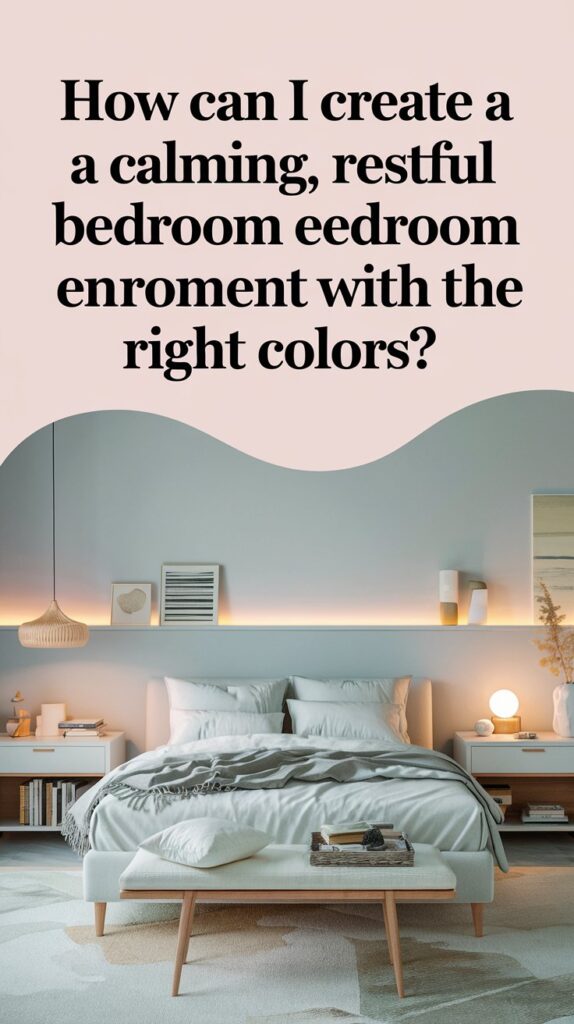1. Choosing Calming Color Schemes
Soft Blues and Greens
- Blue and green are naturally calming colors often associated with nature, water, and open spaces, making them ideal for creating a serene atmosphere. Light, muted shades of blue, like powder blue or sky blue, can evoke a sense of calm and make the room feel more spacious.
- Green, especially in soft hues like sage or mint, brings an earthy, grounding feel to the bedroom. These shades work well as wall colors, accent features, or in bedding and curtains to help create a peaceful environment.
Neutrals and Pastels
- Neutral colors such as beige, ivory, light gray, and taupe can add subtle warmth and comfort. These shades are versatile and can easily blend with any bedroom decor style.
- Pastel shades, such as blush pink, pale lavender, and soft peach, can add gentle color without overwhelming the space. These shades work well on walls, bed linens, and decor items.
Earthy Tones
- Colors like soft browns, terracotta, and muted greens reflect the natural world and provide a cozy, warm feel. They help foster a sense of security, making the bedroom feel like a comforting escape.
Monochromatic Themes
- Using a monochromatic color scheme, where you apply varying shades of one color, can simplify the decor and create visual harmony. Light shades of gray or taupe, for instance, can make the room feel calming and unified, which is particularly helpful if you prefer minimalism.

2. Deciding on Accent Colors
While the main colors in a calming bedroom should be soft and soothing, carefully chosen accents can add personality without disrupting the tranquility. Here’s how to use them:
Cool Accents for Freshness
- Accent pillows, throws, and small decor items in colors like teal, emerald green, or navy can add a sense of freshness to the room. Stick to cooler tones to avoid overpowering the calming vibe.
Muted Warm Accents
- Incorporate soft versions of warm colors like blush, lavender, or pale coral as accent colors in your bedding, curtains, or artwork. These colors add warmth without overwhelming the space, maintaining a sense of calm.
Using Natural Elements as Accents
- Adding materials like wood, rattan, or clay brings an organic touch to your bedroom. Choose furniture pieces or accent items in natural wood tones that complement the calming color scheme and provide a grounded, earthy element.
3. Color Psychology in the Bedroom
Understanding the psychology behind colors can help you choose shades that positively influence your mood and promote relaxation:
- Blue: Known to reduce stress and lower blood pressure, blue is an ideal color for a bedroom. It evokes calm, stability, and peace, making it a great option for walls or bedding.
- Green: Often associated with balance and renewal, green helps you feel relaxed and at ease. This color works well for people who want a grounding, nature-inspired look in their bedroom.
- Lavender: This light purple shade has a calming effect similar to blue but with a touch of warmth. It’s gentle enough to promote relaxation without making the room feel too cool.
- Gray: Light gray tones add sophistication and neutrality, which can enhance relaxation. Gray provides a balanced backdrop that works well with other soft colors.
- Pink: Soft blush tones can make a room feel warm, welcoming, and comforting. Pink is often associated with calmness and has been shown to reduce feelings of aggression or anxiety.
4. Color Placement and Design Techniques
Where you place colors in your bedroom is just as important as the colors you choose. Here are some tips for placing colors to maximize their calming effects:
Walls as a Calming Backdrop
- Painting your walls in a soft, neutral shade can create a restful environment and make the space feel more open. Lighter colors on the walls help reflect natural light, brightening the room and giving it an airy feel.
Soothing Bed Linens
- Opt for light, calming colors in your bedding to ensure a restful visual space. Soft hues like ivory, light gray, or gentle pastels in sheets, pillowcases, and duvet covers create a seamless flow that contributes to relaxation.
Accents in Moderation
- Small accents like decorative pillows, bedside table accessories, or artwork should be limited to one or two soft colors that complement the room’s primary palette. This helps prevent visual clutter, which can disrupt a peaceful ambiance.
Window Treatments and Curtains
- Choose curtains or blinds that match or complement the wall color to create a cohesive look. Light-filtering curtains in soft shades allow natural light to enter during the day, keeping the room bright while maintaining privacy and a restful atmosphere.

5. Lighting Considerations
Lighting also plays a significant role in the perception of color and can influence how calming your bedroom feels. Here are some lighting tips to enhance your calming color scheme:
Natural Light
- Maximize natural light by choosing sheer or light-filtering curtains that allow daylight to flow in gently. Natural light will amplify the calming effects of your wall colors and create a serene, open feel.
Warm Ambient Lighting
- Use soft, warm-toned bulbs in lamps or ceiling lights to create a cozy glow. Warm lighting complements neutral and pastel tones and enhances the relaxing feel of your color scheme.
Dimmer Switches
- Consider installing dimmer switches, which allow you to adjust the brightness to suit different times of day and moods. Lower lighting levels at night can help signal your body to relax and prepare for sleep.
Accent Lighting for Ambiance
- Use small accent lights, such as a bedside lamp or fairy lights, to add gentle light sources without overwhelming the room. Choose shades that match the rest of your decor to keep the space cohesive.

6. Textures and Materials for a Calming Effect
Color isn’t the only element that contributes to a calming bedroom; texture also plays a significant role in creating a relaxing atmosphere. Here are some textures that pair well with calming colors:
Soft Fabrics
- Opt for fabrics like cotton, linen, and silk, which feel soft and comforting. Incorporate them in bedding, throw blankets, and cushions to enhance the soothing ambiance.
Natural Elements
- Materials like wood, stone, and jute add an earthy touch that complements a calming color palette. Consider furniture made of light wood or a jute rug for an organic feel.
Layering for Comfort
- Layering different textures in similar shades, such as a plush duvet with a knit throw and soft cotton sheets, adds depth to the color scheme without disrupting the calming effect.
7. Minimalist Decor and Decluttering
A clutter-free environment enhances the calming effects of your color choices. Here are some tips to maintain simplicity in the bedroom:
Stick to Essential Furniture
- Limit the amount of furniture to keep the space open. Essential pieces like a bed, nightstand, and dresser in neutral tones or soft shades will make the room feel airy.
Organized Storage Solutions
- Keep your bedroom organized with storage solutions like baskets, boxes, and under-the-bed storage. Neutrally colored storage pieces will keep everything tidy without adding visual clutter.
Decorate Sparingly
- Choose a few simple decor items that enhance the color scheme, like a piece of wall art or a small plant. Too many items can create distraction and reduce the room’s calming effect.

8. Incorporating Personal Style with Calming Colors
Finally, consider how to incorporate elements of your personal style within the boundaries of a calming, restful bedroom:
Subtle Patterns
- Patterns can add interest without disrupting calmness. Opt for simple patterns in subtle, soft shades, such as stripes or gentle florals, which add visual texture while maintaining tranquility.
A Touch of Metallic
- Small metallic touches in silver or brushed gold can add a sophisticated touch that doesn’t disrupt the color scheme. Choose one or two accents, like a lamp or picture frame, for elegance without overstimulation.
Personal Art and Mementos
- Select a few pieces of artwork or personal mementos that align with your color palette. Artwork in neutral tones or calming colors can add character to the room without overwhelming the atmosphere.







